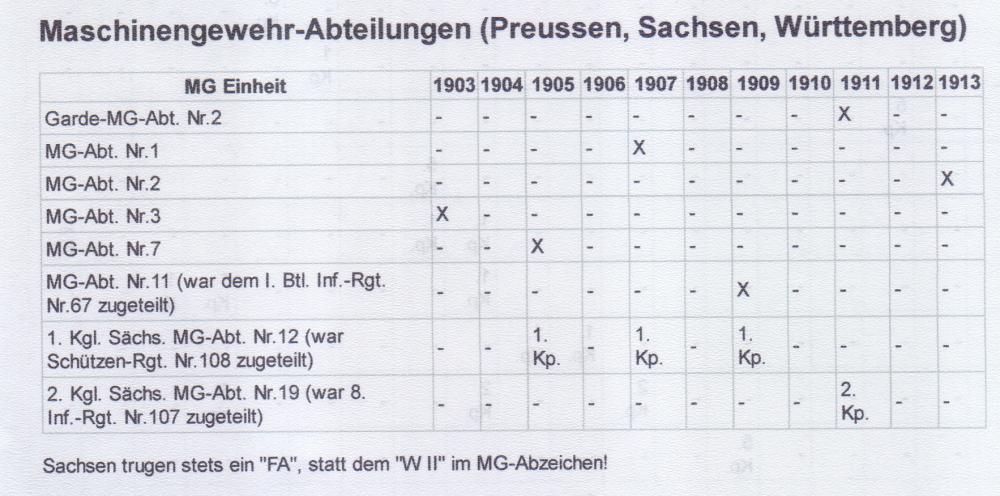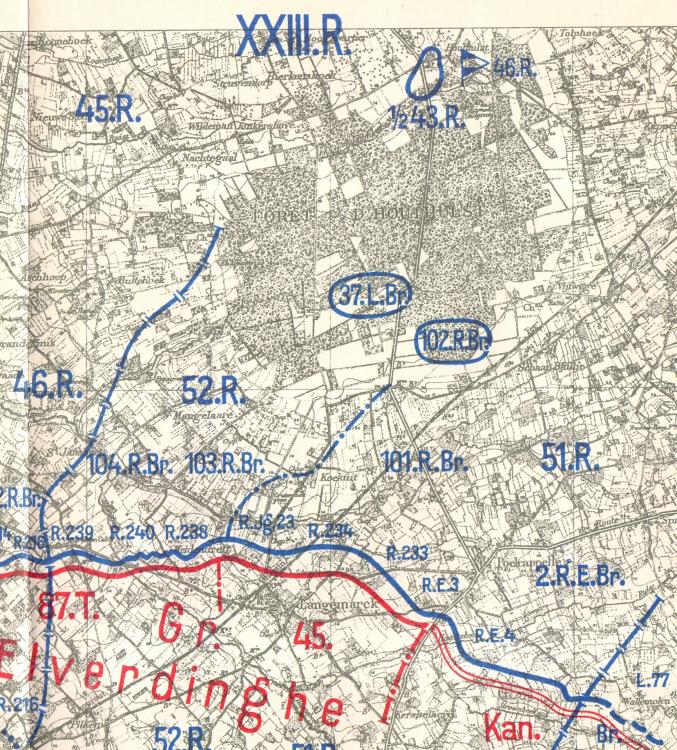-
Posts
3,101 -
Joined
-
Last visited
-
Days Won
6
Content Type
Profiles
Forums
Blogs
Gallery
Events
Store
Everything posted by The Prussian
-

Identification of unit
The Prussian replied to dante's topic in Germany: Weimar Republic & Deutsche Freikorps
Hello Paul! Freikorps Paulssen wore those badges. Cloth patches were also worn. It´s the coat-of-arm of the Hohenzollern. Freikorps Paulssen built together with Freikorps Kühme and Detachement Fulda the Detachement Lierau. They belonged to the Freikorps Schlesien. Freikorps Paulssen was set-up 10.12.1918 by members from Geb.MG-Abt.229 (three companies) Since 1.1.1920 it became Reichswehr-Geb.MG-Abt.201 BUT! Maybe it´s a war-photo... The 1.Garde-Regiment zu Fuß had those Hohenzollern coat-of-army upon their steel-helmet. Maybe they had sleeve-badges too??? 1st Rgt.z.F. could fit, because I can´t see anything upon the the shoulder straps and he wears Garde-Litzen. http://www.erstes-garderegiment.de/Geschichte/Geschichte8.htm The 1.Garde-Rgt.z.F. was I.Btl. of Freikorps Potsdam. Unfortunately I don´t know their badge. I think they had crossed swords behind a steel-helmet. -
Brilliant research! Chapeau, mes grognards! Note, that the recruitement was in Nice. The regiment had its garrisson in Antibes, a few kilometres from Nice. The regiment fought in 1914 in Lorraine, battle of the frontiers, battle of the "trouée des Charmes", and at the Marne In 1915 at Verdun and in 1916 at Verdun and upper Alsace. In june 1916 the regiment was dissolved. On the regimental flag the battle of the Marne is mentioned: "La Marne 1914"
-
Hi Chris. From 9.9.16-28.6.17 were the Trenchbattles at the Narajowka, between Narajowka and Zlota-Lipa and at the Ceniowka. The saxon 24.Res.Div. had been there since 29.4.17 and the saxon 53.Res.Div. since 23.11.16. The all fought with other troops under command of the Südarmee. The turkish XV.Korps too! Maybe the Saxons fought with the turks. Here is a map from summer 1917. But the fact, that there are three high ottoman medals, let me think about the Militärmission
-
As far I can read the document, the prootion is from march 13, 1917. The date of 1919 will be just a post-war letter of confirmation. Maybe he was a philatelist. There was a Felix Piensser in 1959: http://www.philclub-bavaria.de/wir_ueber_uns.htm He served in the Feldpost in 1939??? N° 27: http://gliederungundstellenbesetzung.blogspot.de/2012/11/stabe-des-armee-ober-kommando-18-aok-18.htm I´m not sure, if it´s the same one...
-
By the way. Here is the 5/31 in 1902 (Company leader: Hauptmann v. Keyser. The officer in the centre of the photo with the bright coat near the bicycle)
- 48 replies
-
- for research
- headwear
-
(and 1 more)
Tagged with:
-
As I asked in #23: Which criterions must a unit fulfil to be a good (or the best) unit? It´s really hard to say. A brilliant unit on the western front could fail in the mountains of Tyrol. The best marksmen in the pre-war era was the 5./Inf.Rgt.31. They recieved the Kaiser-Badge each year from 1898-1904. Seven times in sequence. But do we hear a lot of that unit in the war? What about Inf.Rgt.146? They did see everything, but the western front. So they are not mentioned according to the "Great" battles like Verdun or the Somme. 1914: East-Prussia, south and north Poland 1915: Galicia, Poland and Serbia 1916: Macedonia 1917 and 1918: Palestine and Syria So again my friends: What is a good unit? To me the best unit would be a unit with the most engagements and the least casualties OR the unit with the most awards in the war. But who is able to count? I can recommend a book (but it´s about WW2): Martin van Creveld: Fighting Power ( https://medium.com/@bayobatt/book-review-fighting-power-4a9a8076b5e#.a9nff0beq )
- 48 replies
-
- for research
- headwear
-
(and 1 more)
Tagged with:
-
Hello Paul! These badges were recieved by the entire unit. I think the mentioned saxon companies (1 and 2) were wrong. I assume, they mean Abteilungen. The saxon Abteilungen had a strength of 88 men. There would be no sense to build companies inside that small unit! In 1911 the 1st Abteilung was dissolved for building new MG-companies for the infantry regiments. The 2nd Abteilung became MG-Abteilung 19, but in 1915 it became the 13.comp. of Inf.Rgt.107 The difference between a company and an Abteilung was not a big thing. The strength of an MG-Kompanie was 4 officers and 95 NCOs and men The strength of an MG-Abteilung was 4 officers and 112 NCOs and men
-
Why not? You didn´t had to fight in Turkey to recieve that star. Willi Rohr (Sturmbataillon Rohr) recieved it, just because talking with Enver Pascha about stormtroop tactics... But the units of the See-Bataillon never fought in Turkey. All three Marine-Divisions fought in the western theatre. But an officer of those divions could be attached to the military-mission in the Turkey. That was possible.
- 48 replies
-
- for research
- headwear
-
(and 1 more)
Tagged with:
-
Question: WHAT is a best unit? The one, who killed the most enemies? The one, who suffered less than the others? The one, who conquered the most places or kilometres? The one, which commander had the most medals? The one, with the best equipment? The one, who won a battle with the best ratio? Maybe 1:2 or 1:3?
- 48 replies
-
- for research
- headwear
-
(and 1 more)
Tagged with:
-
Hello! I don´t see something mystic. Well the paper is printed with 1916, but probably they had those papersrecieved in 1915 for two or three years. No-one knew, how long that war would last... The first gas-units were two Pio companies in january 1915. They were first called "Desinfektionstruppe". Those companies came to the 4th army, were raised up to six companies. The OHL ordered to form a regiment with two bataillons with three companies each, end of march 1915. This one was called Pi.Rgt.35 since april 12, 1915. The first gas-attack started april 22, 1915 north of Ypres. Ca. 6 o´clock p.m. the gas-cylinders were opened versus the 87th Territorial and 45th Inf.Div.. The wind came from north with 2m/sec. So this document awarded Vizefeldwebel Schmitt, who was engaged with that regiment in that attack! It was not nice for the belgium troops. The Belgians informed the french high command a few days ago, that there could be a gas-attack. But they ignored it... Gas ain´t good. My grandfather was injured by a gas attack in 1918 Great document!!!!
-
Das ist das Kaffehaferl des k.u.k. Marineoberstleutnant Rudolf Slezak, meines Großvaters That´s the coffee-cup of the k.u.k. Naval-Lt.Col. Rudolf Slezak, my grandfather A Kaffehaferl is an austrian word for coffee-cup Inside of this book you´ll find him. Unfortunately the names-index ends with "Sch", so I couldn´t find him. You´ll have to read the entire book... https://ia802704.us.archive.org/20/items/rangundeinteilu03marigoog/rangundeinteilu03marigoog.pdf

.thumb.jpg.38ecc8aec012a9f588d06e86d08997bf.jpg)

.jpg.9b5081927c8fc23b32170ccc3c0b413d.jpg)
.jpg.0b90f00cbd82adefd6c4d51a4d1d88d2.jpg)
.thumb.jpg.680e6add4102f31f8bd5ac857846d447.jpg)

